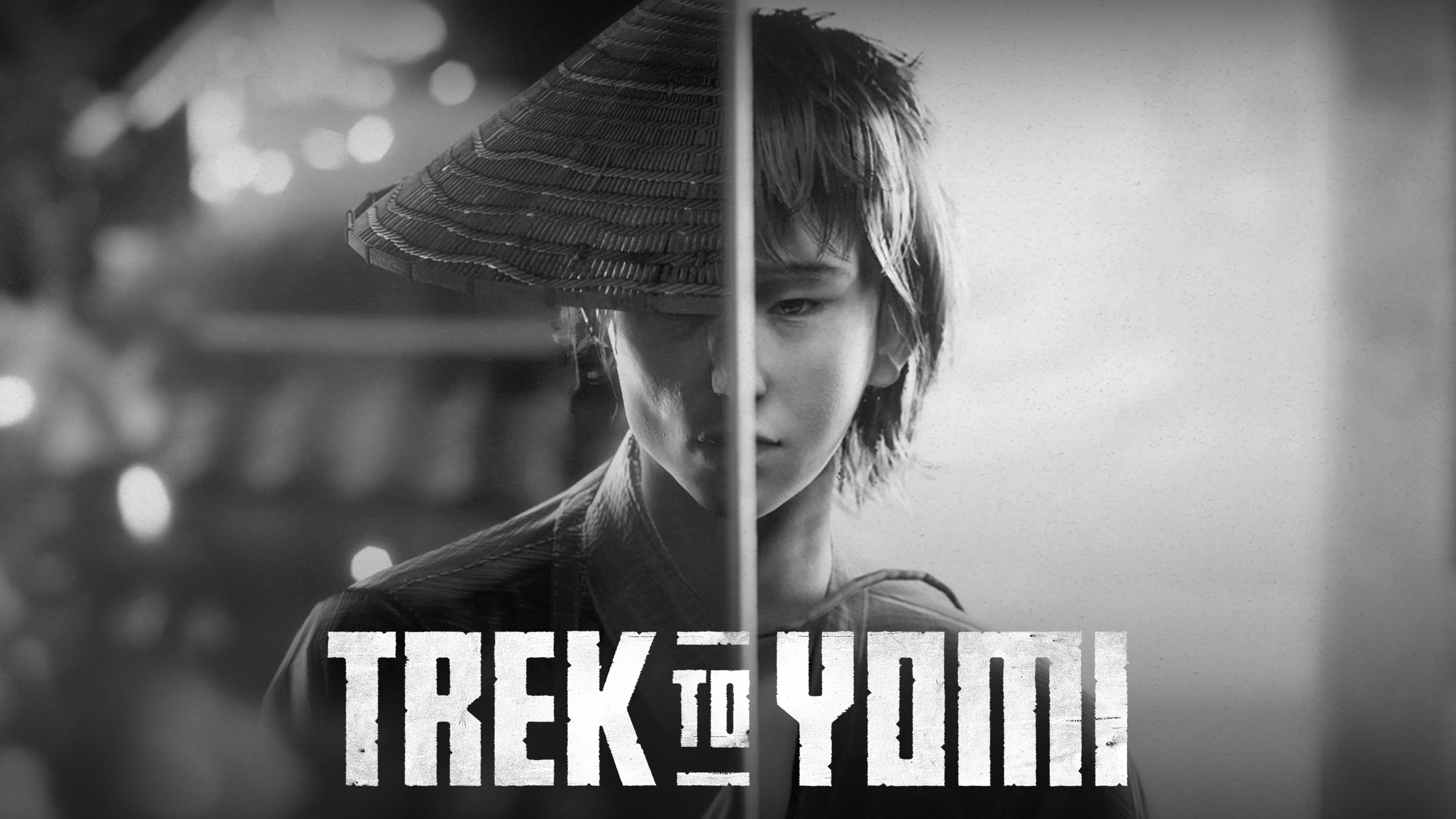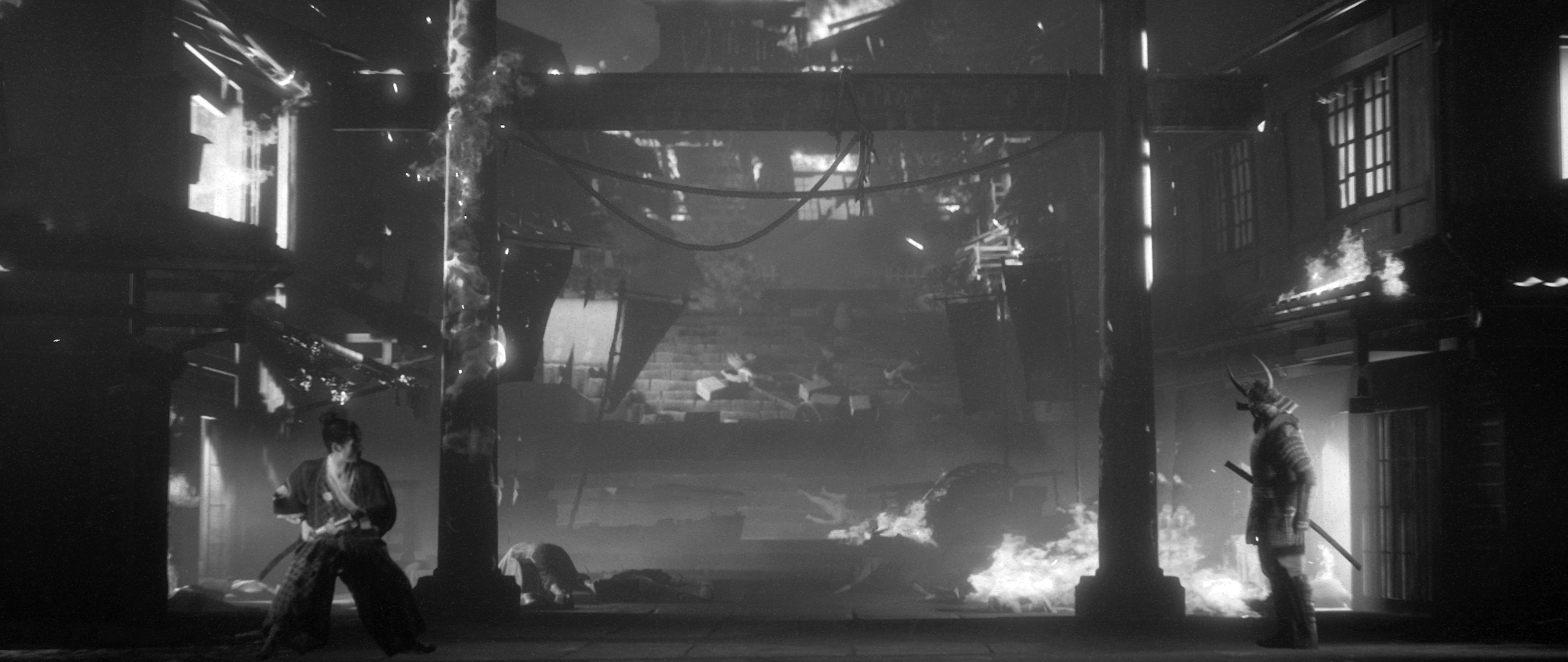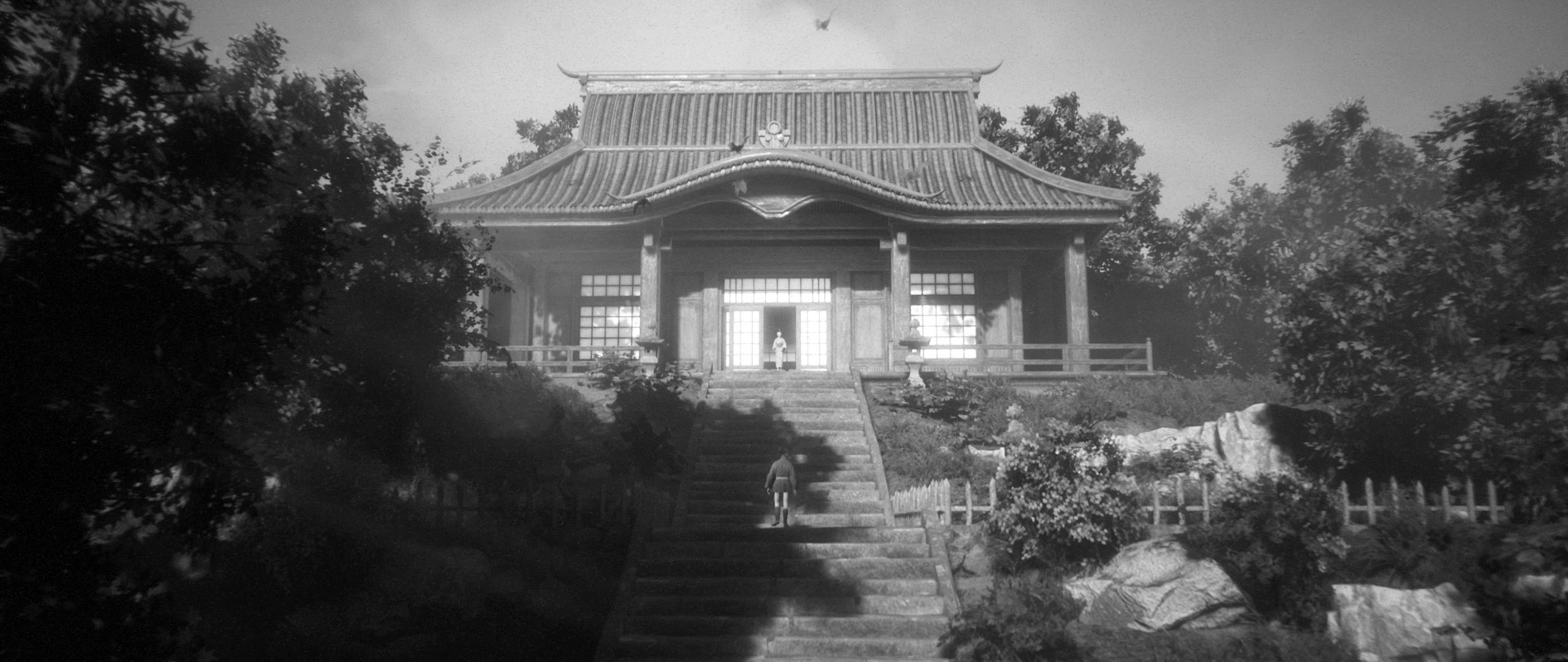The PS4 blockbuster Ghost of Tsushima featured an optional black and white filter called “Kurosawa Mode.” The desaturated visuals and film grain brought to mind the early samurai epics of the eponymous and legendary Japanese filmmaker Akira Kurosawa. If you liked this idea but found the execution shallow and lackluster (like some critics), Trek to Yomi will satisfy your need for authentic Kurosawa inspired aesthetics.
You may, however, be slightly disappointed by a tale that doesn’t hold up to the standards of the master storyteller.
One look at Trek to Yomi and you will see why the black and white art style is so immediately striking. Devolver Digital’s latest release is a collaboration between game designer Leonard Menchiari and Polish studio Flying Wild Hog. The 2.5D samurai action game is set in the Edo period of Japan. The attempt at authenticity in its presentation makes Trek to Yomi an ambitious title worth playing, despite its narrative and mechanical shortcomings.
Trek To Yomi Review: Going Full Kurosawa Mode
From the get-go, Trek to Yomi commits to authenticity. It’s not simply just the black and white look or the optional film grain filter. Loading up the start menu, each English menu option is listed alongside a Japanese kanji. Furthermore, there is no English dub, which means no opting in or out of a Japanese language track. You must play in Japanese with your choice of subtitles.
The score was composed using instruments exclusively from this period of Japanese history. Sound is perhaps the area where Trek to Yomi best captures an element from Kurosawa’s films as serene woodwinds echo throughout the quiet moments and intensifying drums can be heard as you transition from exploration into combat.
The dichotomy between the action and the light puzzle and exploration bits is key to explaining what kind of game Trek to Yomi actually is. Broken up into linear chapters, you play through the life of samurai Hiroki, who begins as a young learner in the tutorial section before the game jumps to his adult life.
One fateful day, his village is raided by bandits and his sensei’s daughter (and Hiroki’s love interest) Aiko is captured. On a revenge and rescue mission, you slash your way through a bloody story full of samurai tropes.
The perspective of Trek to Yomi is from a fixed camera that follows Hiroki during the action but remains static during non-combat sections. While not in combat, you can move Hiroki in 3D. Objects like ammunition and upgrades shine with a silver twinkle. (Those two things can’t help but remind me of classic Resident Evil, especially the 2002 remake).
The way these shots mimic film make every single moment feel hand-crafted and meticulously framed. Trek to Yomi makes its most direct references to Kurosawa by using shot compositions that harken back to Seven Samurai and the classics of the genre. The result is a gorgeous game that feels cinematic in every step, not just during cutscenes.
Trek to Yomi’s combat rewards defensive play and reaction. You are fragile, especially early on, and going in aggro will get you killed quickly. Instead, enemies force you to block frequently, manage your stamina bar appropriately, master parry timing perfectly. It isn’t as punishing as Ninja Gaiden Black or Sekiro, but even on Bushido (medium) difficulty, Trek to Yomi will test your timing and ability to pull off combos.
Combat is most akin to a 2D take on Devil May Cry; it’s a system that requires quick button presses and fighting-game levels of precision to pull off some of the more deadly moves. There is a satisfying depth here that reveals itself as you gain abilities.
As you progress, Hiroki learns more sword skills and finds a handful of ranged weapons, like shurikens and a bow, that have limited ammo you can pick up. The ranged weapons are more like “get out of jail free cards” that stagger enemies mid-combo. The more powerful ones do decent damage, but ammunition is limited enough that you have to use them strategically during the more overwhelming encounters.
Alternatively, you can save your ammo to make quicker work of the bosses, none of which feel especially long or complicated. This works in the game’s favor, though. A boss might destroy you three or four times in a row, but it doesn’t take long to pick up on their weaknesses. When you finally achieve victory, it is extremely rewarding to be able to take one down in 30 seconds.
The majority of the combat, though, is sword based. As you progress, you gradually unlock more offensive and defensive skills. Many of these are unlocked after mandatory battles, but some are hidden away behind optional or secret paths where you can also find health and stamina upgrades. If you are trying to seek out every single sword skill, though, you might be in for a frustrating time.

Each level hides 5-10 collectibles that give historical context but don’t have any gameplay impact. When you go down an optional path, any number of items could be awaiting at the end. You never really know if you are going to get a health upgrade, new skill, or just a collectible. I can see how some players might find this exciting, but poorly communicating the difference between the path forward and the side paths is an issue.
It’s not always clear which path is the one forward and when you progress far enough along the main path to reach the next required combat scenario, there is no going back. You can load your last checkpoint if you realize you missed something in time, but there is no chapter restart and no post-game chapter select.
Once you beat Trek to Yomi, you are booted to the main menu and have to start over. The lack of a chapter select or New Game+ mode means most players probably won’t have an incentive to play again. I ended up short a handful of skills by the end of my 7-hour play time and was left wishing I could easily go back in and track down the ones I missed. Perhaps they would have made those last couple hours feel less tedious.
That’s because the difficulty (and monotony) begins to increase near the end of Trek to Yomi. In the last couple of hours, each encounter starts to feel like the last, only harder and longer. It doesn’t help that the game is more or less a linear path of encounters. There are a handful of environmental puzzles that essentially boil down to the world’s easiest game of Memory, a last-minute inclusion to break up the pacing. Just not a fun one.
More disappointing than these puzzles, though, is the story. Trek to Yomi’s first half is an extremely by-the-book tale of a samurai whose village gets invaded. His life destroyed, he goes on a quest that blurs the line between honor and vengeance. You don’t get much of a feel for Hiroki or Aiko as characters beyond the archetypal roles they fill.
This is due in part to the writing, which feels like a disjointed translation. Many of the subtitles sound unnatural in the way an old anime dub would. Thankfully, the story takes an unexpected turn about halfway through.
I won’t give it away, but suffice to say the second half of Trek to Yomi allows the artists to stretch their creative limbs. For a game with such strong visual design already, this feels like a well-considered choice that leans into its strengths. The lack of any emotional attachment to the characters still muted my connection to the world, though. By the time credits rolled, I still didn’t find myself particularly invested in the characters, despite the visual splendor.
Trek to Yomi Review — The Bottom Line
Pros
- Stunning visual and audio design.
- Fundamentals of combat are satisfying.
- Makes great use of fixed camera angles.
Cons
- Characters are boring archetypes.
- A bit repetitive in the back half.
- Puzzles are beyond basic and feel tossed in for variety.
- No chapter select or New Game Plus.
Trek to Yomi is a masterclass in presentation. The striking, period-appropriate style and impressive use of fixed camera angles make each screen engrossing, pushing you to see what’s next. The writing doesn’t live up to the nuanced expectation set by styling the game after the works of Kurosawa, and some of the chapters are a bit long in the tooth, but Trek to Yomi is still worth playing for any fan of 2D action or the samurai genre.
[Note: Devolver Digital provided the copy of Trek to Yomi used for this review.]










Published: May 2, 2022 11:50 am